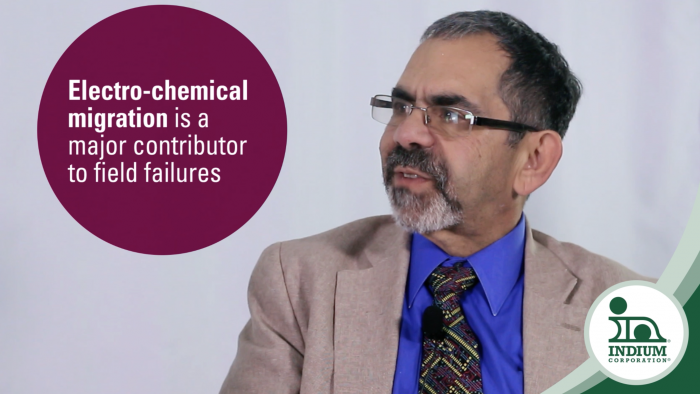Phil Zarrow: Brook, thanks for joining me today. In this four-part series, we're going to be investigating test methods of electrochemical migration assessment and process control.
Starting with electrochemical migration, it's been probably one of the major contributors to field failures in electronic assemblies, for what seems like forever. There has to be four factors for electrochemical migration to take place and they all have to be there. They are...
Brook Sandy-Smith: The four factors are metal, which comes into play from the circuitry.
Phil Zarrow: Yep.
Brook Sandy-Smith: Some sort of a humid environment where water droplets can form on the board and be present to solubilize any ionic residues, that's the third factor—ionic constituents that are left on the board. And, the fourth factor is voltage, which gives the whole system momentum to start growing dendrites and leading to shorts and current leakage and potential failures in the field.
Phil Zarrow: Contrary to popular belief, that doesn't have to necessarily be a very, very high voltage does it?
Brook Sandy-Smith: Not necessarily, I mean there are some people that say that a low voltage is just more steady and it helps it happen faster, too. There are different ways of thinking about it, but sometimes, for instance, automotive electronics, the higher voltage that they're trying to push with the same electronics do lead to cases for faster failures.
Phil Zarrow: Now, briefly, since we're going to go into it in further detail on a subsequent video, the contamination. What are some of the places that contamination can come from?
Brook Sandy-Smith: A lot of times we think of flux residues as being a source of contamination.
Phil Zarrow: Right.
Brook Sandy-Smith: Either no-clean residues that aren't cured properly, or water-soluble residues that aren't cleaned off properly, but there are other sources such as fabrication of your boards: incoming materials such as components or formal coatings or all of the different materials that go into the assembly. The third factor is also human interaction, so as you have operators carrying around the boards, if they have lotion or residues from their food that they just ate at lunch time…all of those things can play a factor.
Phil Zarrow: Now, there a number of different test methodologies that can characterize the cleanliness of a board. We're going to be discussing that, but briefly what are some of them?
Brook Sandy-Smith: The industry has a whole bunch of different standard test methods for assessing the contribution of different factors to the electrochemical migration resistance of an assembly. Industry standard is SIR, Surface Insulation Resistance, because it most thoroughly shows the interaction of these four factors, but there have been newer test methods developed recently, and we'll talk about all of those.
Phil Zarrow: In another installation, we're going to be talking about making the assemblies reliable from a process stand point. Touch on that briefly?
Brook Sandy-Smith: Yeah, SIR as I mentioned, isn't ideal for process control. You're not running an SIR board with every assembly.
Phil Zarrow: Right.
Brook Sandy-Smith: It doesn't really make sense as a process control test, so, yes, there are emerging test methods that have been developed that are more tailored to process control. Meaning they're quicker, they can be done on a small area, they're not destructive. Those kinds of factors are really important in finding a test method that is tailored for process control.
Phil Zarrow: We're going to elaborate on these in a subsequent videos, but what are some of the resources our listeners can go to?
Brook Sandy-Smith: Yeah, in addition to the subsequent videos for this series, you could find my papers on this topic, which are available at www.indium.com, or if you have questions or comments you're always free to contact me directly at bsandy@indium.com.
Phil Zarrow: Brook, thank you so much.


